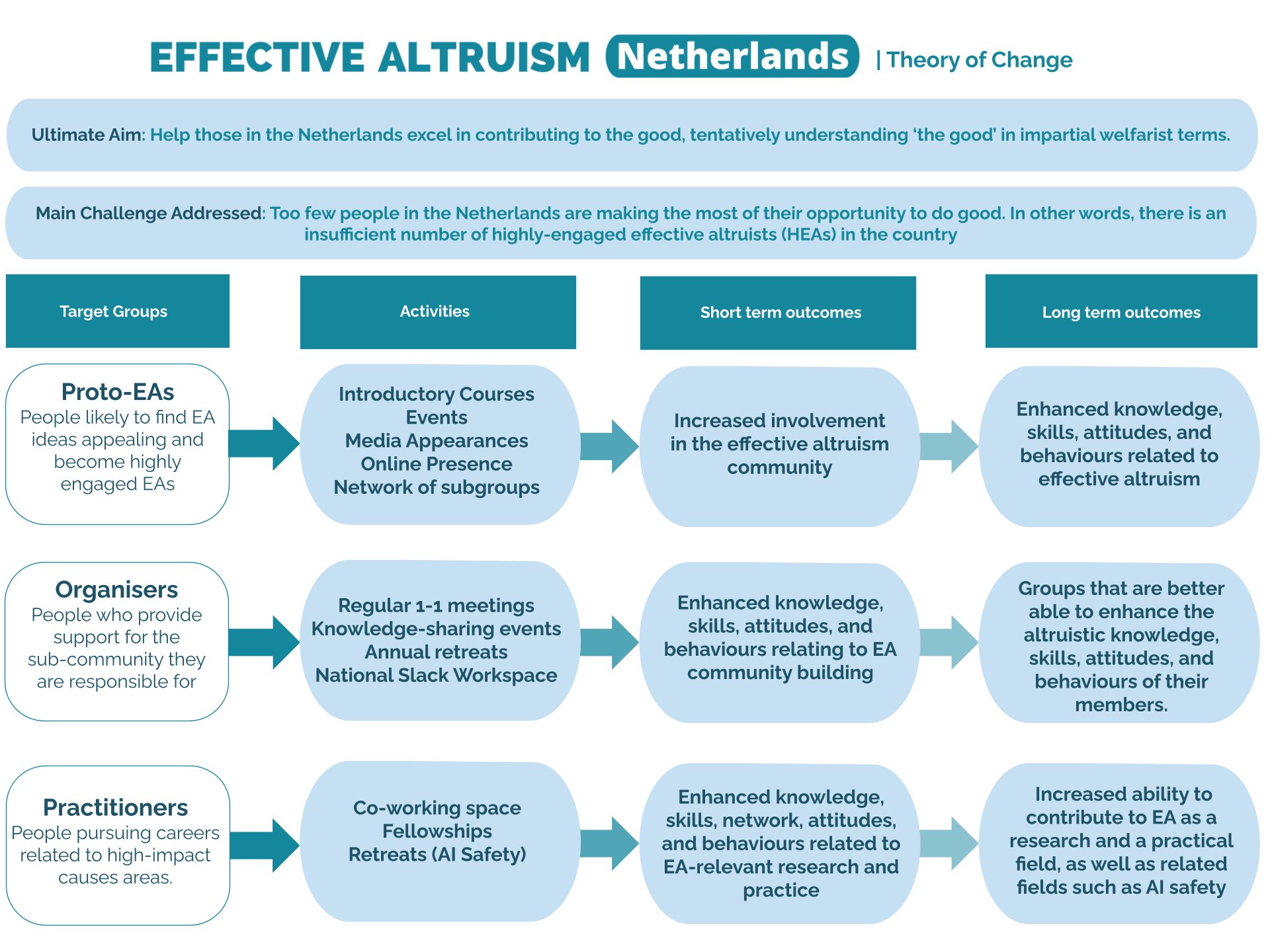Below is a summary of our theory of change. We've been working with this theory for well over a year now, but it hasn't been widely shared.
To develop it, we followed Charity Entrepreneurship’s advice and used these three sources as a guide. However, we mostly used this, which is an updated version of one of the aforementioned sources.
It isn't complete. We have a 35-page internal doc with the situation analysis, detailed descriptions of the target groups, etc. However, a few parts are out of date so we'd rather not share it widely. There are also several best practices we still need to incorporate, as suggested in resources such as this.
Summary of our theory of change
In diagram form

In written form
Ultimate Aim
Help those in the Netherlands excel in contributing to the good, tentatively understanding ‘the good’ in impartial welfarist terms.[1]
Main Challenge Addressed
Too few people in the Netherlands are making the most of their opportunity to do good. In other words, there is an insufficient number of highly-engaged effective altruists (HEAs) in the country.[2]
Target Groups
- Proto-EAs
- Organisers
- Researchers and practitioners relevant to EA
Proto-EAs
- Activities: Introductory courses, events (EAGxUtrecht), media appearances, online presence, and a network of groups.
- Short-term Outcomes: Increased involvement in the EA community.
- Long-term Impact: Enhanced knowledge, skills, attitudes, and behaviours related to altruism.
Organisers
- Activities: Regular 1-1 meetings, knowledge-sharing calls/events, annual retreats, EAGxUtrecht, and a national slack workspace.
- Short-term Outcomes: Enhanced knowledge, skills, attitudes, and behaviours relating to EA community building.
- Long-term Impact: Groups that are better able to enhance the altruistic knowledge, skills, attitudes, and behaviours of their members.
Researchers and practitioners relevant to EA
- Activities: Co-working space, retreats (e.g., AI safety), EAGxUtrecht, and fellowships (in progress).
- Short-term Outcomes: Enhanced knowledge, skills, networks, attitudes, and behaviours related to EA-relevant research and practice.
- Long-term Impact: Increased ability to contribute to EA as a research and a practical field, as well as related fields such as AI safety.
FAQ
Q. What about existing members of the community?
A. Our strategy is to have a thriving network of organisers who will serve the needs of this target group. We supplement this with very light-touch things, e.g., a national WhatsApp community, a volunteer trust person, small events at our office, etc. So far, this has been working OK, and has freed us to work on things that otherwise wouldn't get done.
Q. What about career switchers?
A. We experimented with this target group but found we weren't particularly successful. Around the same time, the School for Moral Ambition began to get off the ground, so this area felt far less neglected. Therefore, we decided to put our resources into field building (that's the 'researchers and practitioners relevant to EA' target group).
Q. How are you doing monitoring and evaluation?
A. Not well enough, but we're getting better and have plans[3] and a budget to invest in this further in the second half of 2024.
Some programmes are fairly easy to monitor. For example, last year we had about 60 national intro programme completions,[4] the average LTR was 8.8/10, the average score on the exit quiz was 83%, and 44% reported feeling ‘a good deal more’ or ‘substantially more’ inclined to choose a high(er)-impact career path.
In addition, CEA asks us to produce an annual report where we detail our progress and provide a set of 12 case studies (examples of individuals who have interacted with us and have then gone on to do cool things).
Eventually, we want to have robust monitoring systems for each of our programmes, we want to be running evaluations every couple of years, and we want to have a monitoring system for the entirety of the EA movement in the Netherlands.
Q. Don't you have too many activities?
A. Maybe.
- ^
As a tentative hypothesis or a first approximation, ‘doing good’ is about promoting wellbeing, with everyone’s wellbeing counting equally. See MacAskill’s ‘The Definition of Effective Altruism’, available here.
- ^
An HEA is someone who is motivated in part by an impartial care for others, is thinking very carefully about how they can best help others, and who is taking some significant actions to help. In practice, this might look like selecting a job or degree program, donating a substantial portion of their income, or working on EA-related projects, etc. Note: one does not need to identify as an effective altruist to be an HEA.
- ^
Based on this excellent resource.
- ^
This doesn't include the completions generated by the local groups. If you include these, we had around 300 completions.

A late reaction James and Marieke. However, I wanted to say thanks for sharing this well-thought-through document. In my view, it highlights how a Theory of Change on an organizational level can contribute to making choices and strategizing. Love it.
Thanks Nicoll! There's much we can improve but I'm glad we've published something :)
Executive summary: The post outlines a non-profit organization's theory of change for promoting effective altruism (EA) in the Netherlands, with the ultimate aim of helping people excel at contributing to the greater good, defined tentatively as promoting wellbeing impartially.
Key points:
This comment was auto-generated by the EA Forum Team. Feel free to point out issues with this summary by replying to the comment, and contact us if you have feedback.